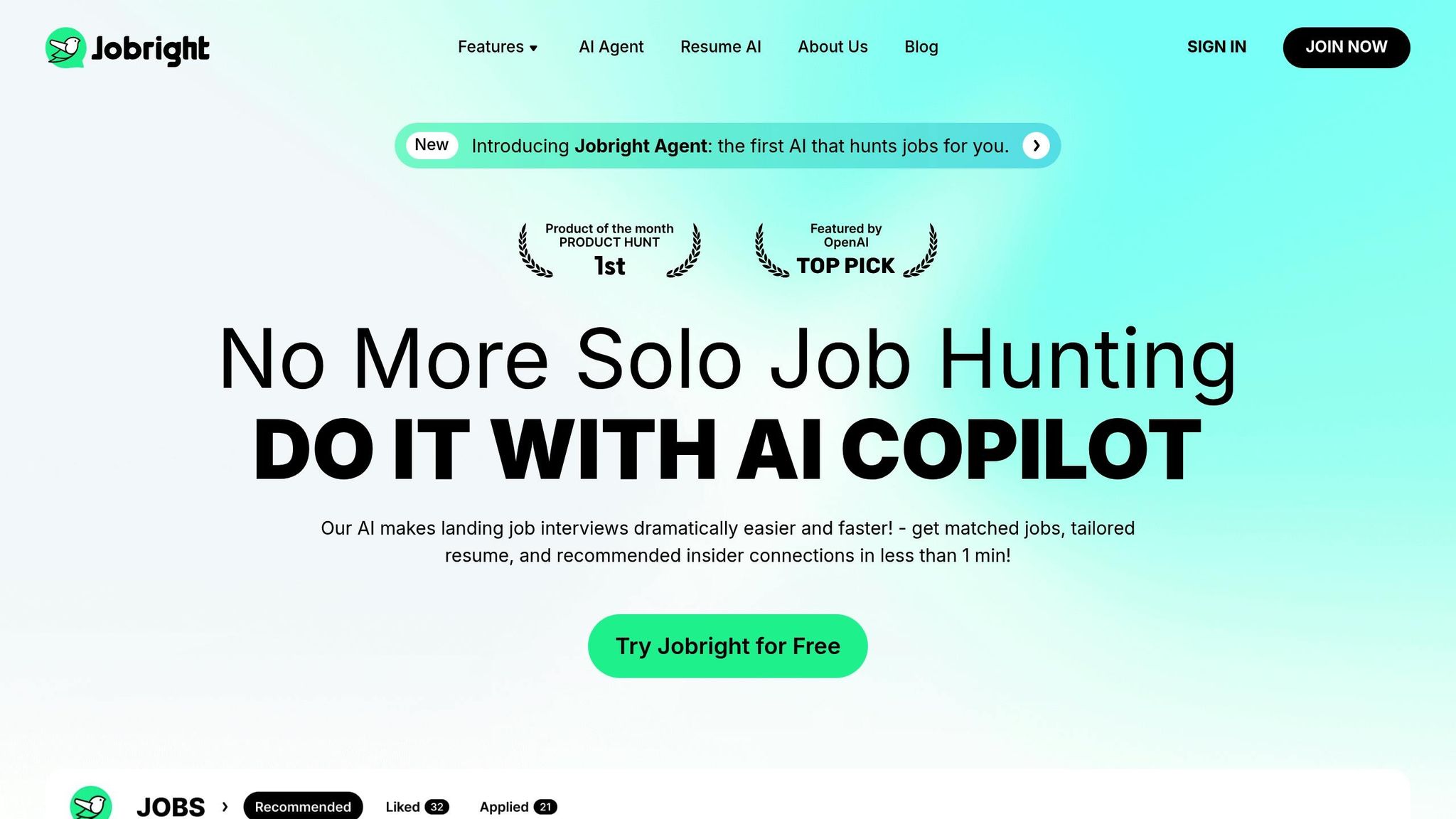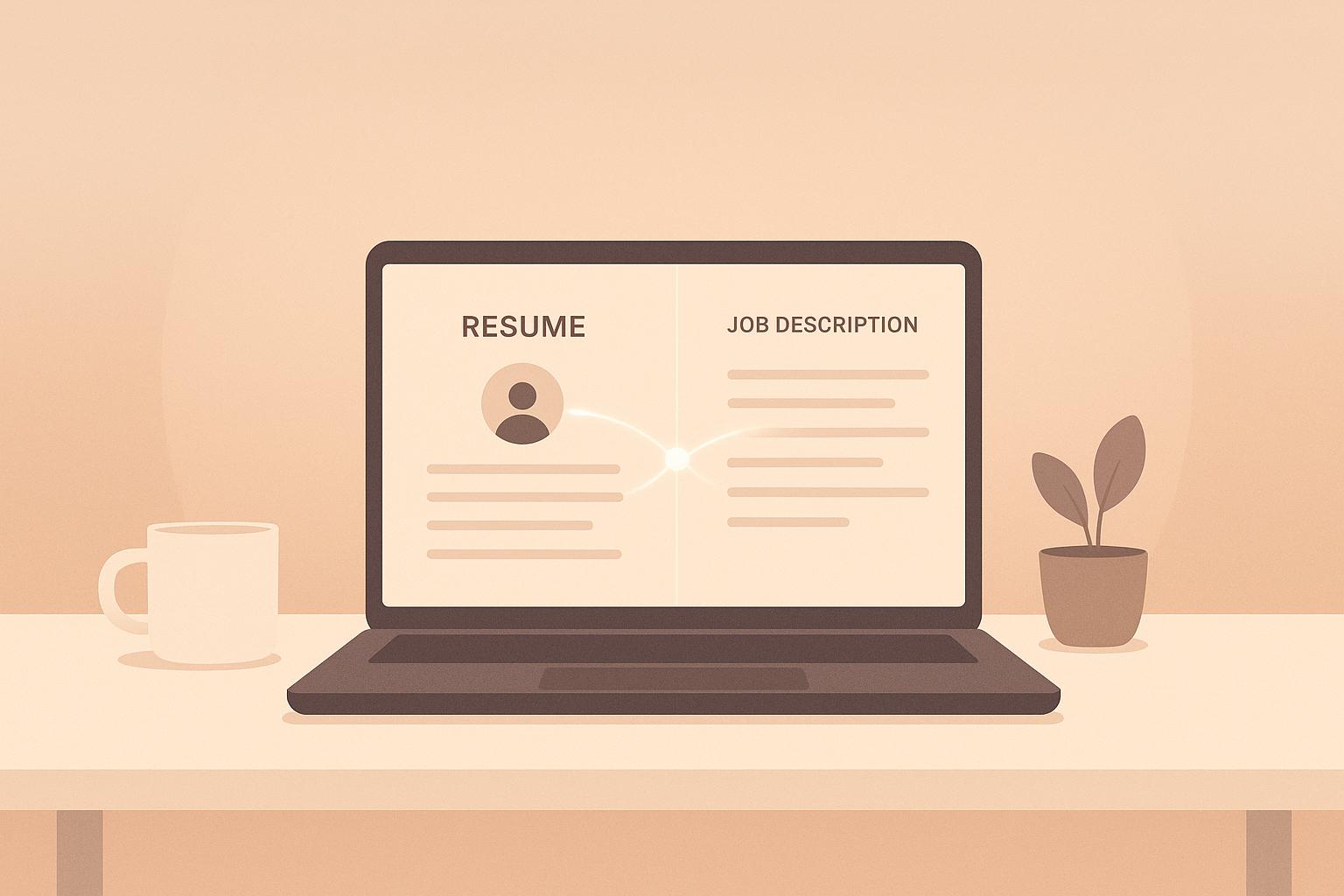Multi-platform job integration simplifies job searches by combining multiple job boards and applicant tracking systems (ATS) into a single platform. This approach eliminates the hassle of managing scattered applications and accounts, helping job seekers stay organized and efficient. Key features include:
- Centralized Dashboards: Manage all applications, deadlines, and updates in one place.
- Automatic Tracking: Real-time updates on application progress, reducing manual follow-ups.
- AI Insights: Analyze employer data, job trends, and salary benchmarks for smarter decisions.
- Data Accuracy: Sync profiles across platforms to avoid errors and inconsistencies.
With tools like JobSwift.AI, users can streamline their job search using AI-powered tools for resume matching, employer analysis, and scam protection. Plans start with a free option or $249.99 annually for advanced features. This integration saves time, reduces errors, and improves job search outcomes while addressing challenges like data security and technical compatibility.
Core Features of Multi-Platform Job Integration
Centralized Application Dashboard
Think of a centralized application dashboard as your job search headquarters. It’s where all your applications, deadlines, interview schedules, and progress updates come together in one easy-to-navigate space. Instead of juggling multiple job boards, email accounts, and spreadsheets, you get a single, streamlined view of everything.
This setup not only keeps you organized but also helps you avoid embarrassing mistakes like submitting duplicate applications. Plus, it eases the mental load of job hunting by letting you focus on strategy rather than logistics. With a clear snapshot of your application status, you can follow up with employers at the right time and manage your schedule more effectively.
And here’s an eye-opener: 42% of recruiters say they lack the resources needed to succeed.
Platforms like JobSwift.AI take this concept further by offering features like real-time updates and tools to prevent duplicate submissions. It’s a game-changer for staying on top of your job search, and automatic tracking takes it even further by keeping you informed every step of the way.
Automatic Job Application Tracking
Automatic job application tracking does the heavy lifting when it comes to staying updated. It connects with various job boards and company systems to track your application’s progress and alert you to changes in real time. For example, if a recruiter moves your application from "under review" to "interview scheduled", you’ll know immediately - no need to keep refreshing your email or logging into multiple platforms.
This feature is especially important given that 98% of Fortune 500 companies use an applicant tracking system (ATS). The efficiency gains are significant: using an ATS can cut the hiring cycle by 60%. For job seekers, that means faster feedback and better communication throughout the process. In fact, 94% of recruiters say ATS tools have improved their hiring workflows.
Beyond saving time, automatic tracking keeps your job search organized, even during high-pressure periods. With built-in communication tools, you’ll never miss critical updates or deadlines. And while tracking keeps you informed, AI-powered insights take it a step further by helping you evaluate potential employers.
AI-Powered Employer Insights
AI-powered employer insights go beyond surface-level information, offering a deep dive into potential employers. These tools analyze company culture, values, mission statements, and how well your profile aligns with their expectations. It’s like having a personal career advisor that helps you assess whether a company is the right fit for your long-term goals.
The AI also scans massive datasets to uncover job market trends, from in-demand skills to salary benchmarks and emerging roles. This helps you fine-tune your applications and pinpoint areas where you might need to upskill. By comparing your profile with company culture, you can boost your chances of finding a role where you’ll thrive.
The adoption of AI in recruitment is skyrocketing. For instance, 68.1% of recruiters report increased use of AI tools, and 72% prefer AI for sourcing candidates. Even more striking, 79% believe AI will soon play a role in hiring and firing decisions.
These insights don’t just guide your job search - they give you a competitive edge. Armed with data on talent trends, salary expectations, and industry demand, you can make smarter decisions about which opportunities to pursue.
"It's everywhere, and it's essential to filling open roles with incredible talent and retaining them for the long haul." – Mahe Bayireddi, CEO and co-founder, Phenom
JobSwift.AI harnesses this technology to offer a two-way matching process. It doesn’t just show you what companies want - it helps you determine if those companies align with your values and career aspirations. The result? Better job matches and higher satisfaction for both you and your future employer.
Key Benefits for Job Seekers
Time and Effort Savings
Searching for jobs across multiple platforms can feel like a never-ending task. But multi-platform job integration simplifies this process, allowing you to apply for several positions with just a few clicks. No more spending hours filling out the same details repeatedly - automation takes care of it for you, saving time and energy.
The efficiency boost is clear. Jobs using Indeed Apply, for instance, see 20% more clicks than those without it. Plus, companies with integrated hiring systems report hiring cycles that are up to 86% faster. For job seekers, this means quicker responses and a smoother application process. Tools like JobSwift.AI go a step further, offering features like automated acknowledgments and real-time updates, so you’re never left wondering about the status of your application.
Better Data Accuracy and Consistency
Keeping your information consistent across various job boards can be tricky. Multi-platform integration solves this by syncing all your data - like your profile, work history, and skills - into a single, unified view. This ensures your details are always accurate and up-to-date.
Automatic synchronization also helps you avoid common mistakes, like submitting an outdated resume or mismatched employment dates. With 80% of digital organizations predicted to struggle without modern data management practices, having accurate and consistent information is more important than ever.
These platforms also use AI and machine learning to validate your data, flagging and correcting any errors quickly. This means your applications are not only complete but also professionally formatted, helping you make a stronger impression. On top of that, the system provides actionable insights, guiding you toward smarter job search decisions.
Better Job Search Insights
When your data is accurate, it opens the door to smarter job search strategies. Integrated platforms use AI to analyze job market trends in real time, showing you which skills and roles are most in demand. Instead of guessing, you can make career moves based on clear, data-driven insights.
These platforms can also highlight skill gaps and suggest areas for improvement, while offering salary benchmarks to help you negotiate better compensation packages . Considering that 99% of large companies use Applicant Tracking Systems (ATS) to screen resumes, optimizing your resume with relevant keywords and a clear structure becomes essential for standing out.
Insights don’t stop at job postings. About 97% of employers check LinkedIn profiles, and 68% may even review Facebook pages. This makes it crucial to maintain consistent professional branding across all your online profiles.
JobSwift.AI takes things further by providing detailed employer analysis. This feature helps you understand a company’s culture and values before you apply, leading to more informed decisions and better job matches. Ultimately, this can contribute to greater satisfaction and success in your career journey.
Automate Your Job Search Through AI Agent Ft. Jobright AI | Find Jobs - Custom Resume - Auto Apply

sbb-itb-96bfd48
Challenges and Considerations for Effective Integration
Integrating job search platforms can simplify your efforts, but it also comes with its share of challenges. Being aware of these hurdles helps you choose the right tools and protect your information throughout the process.
Data Privacy and Security
Sharing personal information across multiple platforms increases the risk of data breaches. In 2023 alone, the U.S. experienced 3,205 data breaches, impacting over 350 million individuals - a 72% jump compared to 2021. This alarming trend underscores the importance of robust security measures in integrated systems.
Job application data, such as your contact details, employment history, and salary information, is particularly appealing to cybercriminals. Risks include unauthorized access, data misuse, and vulnerabilities during transfers.
To safeguard your information, prioritize platforms that use strong encryption protocols for both stored and transmitted data. Features like role-based access control (RBAC), multi-factor authentication (MFA), and comprehensive audit trails are essential. These measures ensure that only authorized individuals can access your data and that all activities are traceable.
Platforms like JobSwift.AI take security seriously, adhering to regulations such as GDPR and CCPA. They employ advanced encryption techniques and monitor data in real time to identify potential breaches before they escalate.
However, it’s worth noting that only 56% of organizations have a business continuity plan in place for data breaches. This highlights the need to select platforms that not only prevent breaches but also have solid incident response strategies ready to go.
Technical Compatibility
Technical compatibility is another critical factor in ensuring smooth integration. Mismatched programming languages, data formats, or communication protocols between systems can create hiccups. What works seamlessly on one platform might fail on another.
The solution lies in choosing tools that are designed to work together and follow established industry standards. Platforms with an API-first approach simplify integration by enabling seamless data flow across systems. Look for tools that use standardized formats and protocols to minimize compatibility issues and ensure consistent results.
Before committing to any integration platform, thoroughly test its functionality. For example, try submitting a test job application and confirm that your data appears correctly across all connected systems. Regular updates are also key to maintaining compatibility as technology evolves and platforms update their requirements.
Regular Maintenance
Integrating multiple platforms isn’t a "set it and forget it" process. These systems require ongoing attention to stay effective and adapt to changes in the job market. Regularly reviewing system configurations ensures they align with current platform requirements, security policies, and application processes.
As new job platforms emerge or existing ones update, adjustments to your integration system may be necessary. This could involve tweaking connection settings, updating data mapping rules, or fine-tuning automation parameters to meet new requirements.
"To ensure software systems are interoperable and compatible under stress, follow industry standards, maintain consistent API design, and implement robust data validation. It's also necessary to conduct thorough compatibility and stress testing, addressing issues early in development."
– Vani P., VP Digital Solutions @ Pronix Inc
Monitoring performance metrics like data synchronization speed, application accuracy, and system response times is vital. If you notice delays or errors, address them promptly to maintain the quality of your job search. Many platforms, including JobSwift.AI, offer automatic maintenance through rolling updates that don’t disrupt your work. However, it’s still wise to check your applications and profiles regularly to ensure everything remains accurate.
Staying on top of platform updates can also help you anticipate potential compatibility issues before they impact your job search. Tools like JobSwift.AI often provide notifications about changes and adjust their systems automatically to keep things running smoothly. By committing to regular maintenance, you can ensure your integration system stays efficient and secure.
Conclusion
Multi-platform job integration is reshaping how job seekers navigate today’s competitive market. With 90% of managers struggling to find skilled professionals and 58% reporting longer hiring timelines compared to last year, having the right tools at your disposal has never been more important.
By adopting this unified approach, you can simplify and strengthen your job search strategy. Features like centralized dashboards, automated tracking, and AI-driven insights streamline what was once a chaotic, time-intensive process into a more efficient and focused effort.
Key Takeaways
Here’s how these tools can transform your job search:
- Save time and boost accuracy: Automated tracking keeps all your application statuses updated in real time, eliminating the hassle of managing scattered data and ensuring everything stays consistent across platforms.
- Gain actionable insights: With all your job search data in one place, it’s easier to identify which roles generate the best responses, track conversion rates, and fine-tune your strategy based on measurable results.
- Maintain professional consistency: Your information syncs seamlessly across platforms, presenting a polished and organized image that stands out to potential employers.
Getting Started with Integration Tools
If you’re ready to streamline your job search, JobSwift.AI offers an all-in-one solution tailored to address the challenges we’ve discussed. The platform organizes your job listings, application history, employer details, and personal notes in one central hub.
Getting started is simple: upload your CV, install the browser extension, and begin applying effortlessly. JobSwift.AI also includes a job scam protection feature, which flags suspicious activity to help keep your search secure.
"Like all marketing strategies (and let's face it, recruitment IS marketing), a multi-faceted approach works best. Use all the tools in your tool belt. This could also include networking, employee referrals, joining professional associations, optimising the careers section of your website and developing your employer brand." - Leanne Hayter, Recruitment Marketing Expert
With 57% of managers planning to hire in early 2025, now is the perfect time to refine your strategy. JobSwift.AI’s upcoming AI CV optimization feature will help you tailor your resume to beat Applicant Tracking Systems, ensuring your applications make it to human reviewers.
The platform offers flexible pricing to suit different needs, including a free plan for a steady-paced search and a Pro plan at $249.99/year or $39.99/month for those looking to accelerate their efforts. By integrating these tools into your job search, you not only simplify the process but also give yourself a competitive advantage.
FAQs
How does multi-platform job integration make the job search easier for job seekers?
Multi-Platform Job Integration
Multi-platform job integration takes the hassle out of job hunting by syncing job listings across different platforms automatically. This ensures job seekers only see current, open positions, cutting down on confusion and saving time. No more jumping between multiple websites to find accurate postings - everything is in one place.
For recruiters, this integration simplifies the posting process, which means more job opportunities are visible to candidates. By reducing the need for repetitive manual tasks, it creates a smoother application experience, allowing job seekers to focus on landing the right role faster and more efficiently.
How can I protect my personal information when using job search platforms?
To safeguard your personal information while using job search platforms, consider these important tips:
- Stick to secure networks: Avoid public Wi-Fi and opt for safer options like your home internet or your phone's hotspot, especially when handling sensitive details.
- Share only essential details: Keep your resume limited to basics like your name, email, and phone number. Hold off on sharing your Social Security number, birthdate, or home address until it's absolutely necessary, like after receiving a formal job offer.
- Research employers: Focus on applying to established and trustworthy companies to steer clear of scams or potential data breaches.
By taking these precautions and carefully evaluating the platforms and companies you engage with, you can better protect your personal data.
How can AI insights help me find the right job faster?
AI-powered tools can make your job search smarter and more efficient by aligning your skills, experience, and preferences with opportunities that fit you best. By combing through massive amounts of job market data, AI helps cut down the time you spend searching, ensuring you see roles that match your qualifications and career goals.
Another advantage is how AI reduces bias in the job-matching process. This creates a more tailored and equitable experience, allowing you to concentrate on roles that genuinely align with your aspirations. The result? A job search process that's not just faster but also more focused on what truly matters to you.


